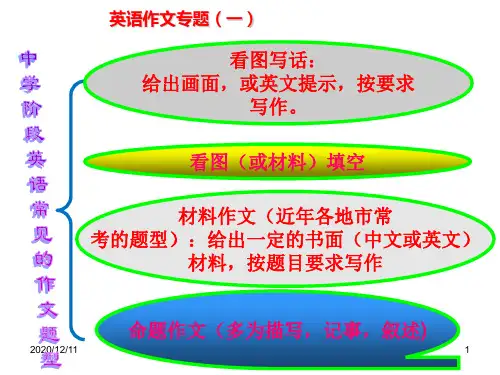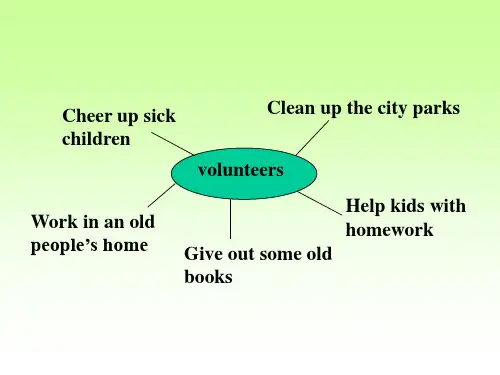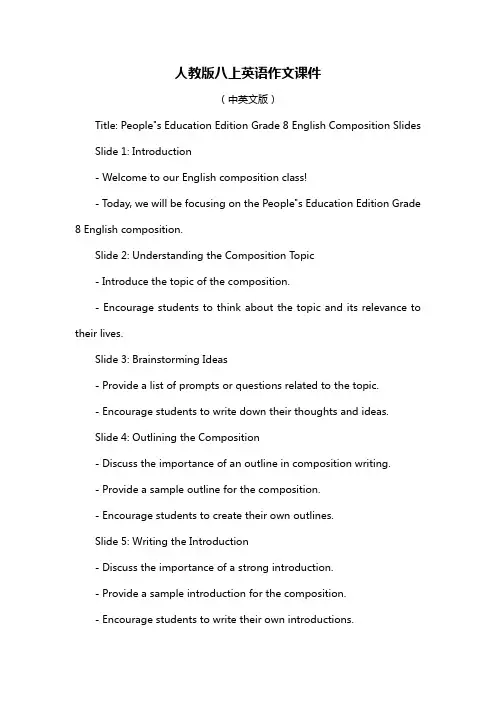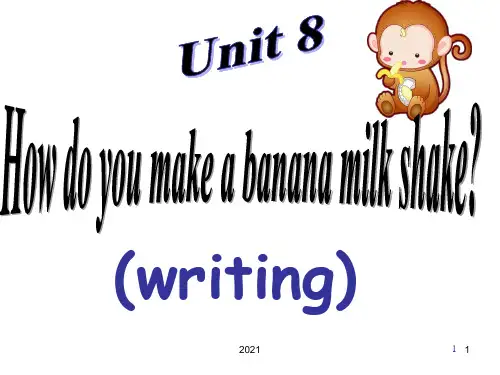初二英语写作(教学ppt课件
- 格式:ppt
- 大小:210.00 KB
- 文档页数:37





人教版八上英语作文课件(中英文版)Title: People"s Education Edition Grade 8 English Composition Slides Slide 1: Introduction- Welcome to our English composition class!- Today, we will be focusing on the People"s Education Edition Grade 8 English composition.Slide 2: Understanding the Composition T opic- Introduce the topic of the composition.- Encourage students to think about the topic and its relevance to their lives.Slide 3: Brainstorming Ideas- Provide a list of prompts or questions related to the topic.- Encourage students to write down their thoughts and ideas.Slide 4: Outlining the Composition- Discuss the importance of an outline in composition writing.- Provide a sample outline for the composition.- Encourage students to create their own outlines.Slide 5: Writing the Introduction- Discuss the importance of a strong introduction.- Provide a sample introduction for the composition.- Encourage students to write their own introductions.Slide 6: Writing the Body Paragraphs- Discuss the importance of body paragraphs in a composition.- Provide a sample body paragraph for the composition.- Encourage students to write their own body paragraphs.Slide 7: Writing the Conclusion- Discuss the importance of a strong conclusion.- Provide a sample conclusion for the composition.- Encourage students to write their own conclusions.Slide 8: Editing and Proofreading- Discuss the importance of editing and proofreading.- Provide a list of common errors to look out for.- Encourage students to edit and proofread their compositions.Slide 9: Peer Review- Discuss the importance of peer review.- Provide a list of questions to ask when reviewing a peer"s composition.- Encourage students to exchange and review their compositions.Slide 10: Conclusion- Recap the main points of the lesson.- Encourage students to practice their composition writing skills.Slide 11: References- Provide a list of references or additional resources for further study.。






初中英语作文写作课优秀课件目录CATALOGUE •Course Introduction andObjectives•Fundamentals of Writing•Writing skills and methods•Common Theme WritingGuidelines•Appreciation and Analysis ofMasterpieces•Writing training andimprovement01CATALOGUECourse Introduction andObjectivesThe Importance of Middle School English Composition•Improving students' comprehensive English proficiency: Throughwriting training, students can better grasp language elements such asvocabulary, grammar, and sentence structures, and improve theiroverall English proficiency.•Developing students' cross-cultural communication skills: Englishwriting is one of the important means of cross-culturalcommunication. Through writing training, students can betterunderstand the culture and thinking patterns of English speakingcountries, and improve their cross-cultural communication abilities.•To lay a foundation for students' future learning and work: GoodEnglish writing ability is an important foundation for students' futurelearning and work, which can provide more opportunities for theirfurther education and career development.Course objectives and requirementsKnowledge objectiveTo master the basic knowledge and skills of English writing, including writing process, article structure,paragraph development, sentence structure changes, etc.Ability objectiveTo independently complete an English article with clear structure, rigorous logic, and fluent language, andpossess certain critical thinking and innovative abilities.Emotional goalTo cultivate students' interest and enthusiasm for English writing, improve their self-learningability and collaborative spirit.Course arrangement and scheduleCourse arrangementThis course is divided into 10 class hours, each lasting 45 minutes. The coursecontent includes explanation of basic writing knowledge, analysis of sampleessays, writing practice, and homework review.Class timeOnce a week, the specific time will be arranged according to the student'sschedule and actual situation.Teaching methodAdopting a combination of online and offline methods, providing coursewareand teaching videos online, and conducting face-to-face tutoring and Q&Aoffline.02CATALOGUE Fundamentals of WritingVocabulary accumulation and application•Positive vocabulary and negative vocabulary: Positive vocabulary refersto words that can directly express the author's intention in the article,while negative vocabulary refers to words that cannot directly expressthe intention but can increase the richness and readability of thearticle.•Semantic analysis and accurate word usage: In English, many wordshave similar meanings, but their usage scenarios and contexts aredifferent. Therefore, when writing, it is important to pay attention toword meaning analysis and choose the most accurate vocabulary toexpress one's thoughts.•Phrases and idioms: There are many fixed phrases and idioms inEnglish, and mastering these expressions can make the article moreauthentic and natural.Sentence Structure and Changes•Simple sentences, compound sentences, and compound sentences:Simple sentences only contain one subject and one predicate; Parallelsentences are composed of two or more simple sentences connectedby parallel conjunctions; A compound sentence contains a main clauseand one or more subordinate clauses.•Sentence pattern transformation and expansion: Through sentencepattern transformation, declarative sentences can be transformed intointerrogative sentences, exclamation sentences, etc., increasing thediversity and expressive power of the article. At the same time,sentence components can also be expanded, such as addingattributives, adverbials, etc., to make the sentence more specific andvivid.There are multiple tenses and voices in English, and using them correctly can make the article more accurate and fluent.The subject and predicate mustbe consistent in person andnumber, otherwise it will lead togrammar errors.Articles, pronouns, andprepositions play importantconnecting roles in English. Usingthese vocabulary correctly canmake the article more coherentand clear. Meanwhile, it is alsoimportant to avoid commonusage errors.Tense and voice Subject verbconsistency Articles, pronouns, and prepositionsGrammar rules and common errors03CATALOGUEWriting skills and methods03Conceptual contentBased on the theme, develop associations, and conceptualize the content and key points of the article.01Carefully review the questioncarefully read the question, understand its meaning, and clarify the writing requirements and limitations.02Determine the themeBased on the requirements of the title, determine the theme and central idea of the article.Topic review and conceptionArticle structure and layoutReasonably arrange paragraphs01Based on the content of the article, arrange paragraphsreasonably to make the article clear in hierarchy.Highlight topic sentences02Set topic sentences at the beginning or end of each paragraphto clarify the central idea of the paragraph.Pay attention to transitions03Use transitional words or phrases between paragraphs to makethe article coherent and natural.Language expression and rhetoric•Accurate wording: Choose appropriate vocabulary to express ideasand avoid using obscure or overly simple words.•Diverse sentence structures: Use different sentence structures toexpress ideas, such as simple sentences, compound sentences, etc., toenhance the expressive power of the article.•Using rhetoric: Use appropriate rhetorical devices such as metaphors,personification, and parallelism to make the article more vivid andvivid.•Pay attention to grammar and spelling: avoid grammar and spellingerrors, and maintain the accuracy and standardization of the article.04CATALOGUE Common Theme WritingGuidelinesNarrative Writing•Select a theme and plot: Choose an interesting story theme and planthe plot development, including the cause, process, and outcome.•Shaping character images: By describing the appearance, personality,behavior, and other aspects of characters, vivid character images arecreated.•Pay attention to detail description: Use vivid details to help readersbetter understand and feel the story context.•Reasonable arrangement of narrative sequence: Different narrativemethods such as sequential, reverse, or interlude can be used to makethe story more engaging.Choose a familiar objectof explanation, such as an object, event,phenomenon, etc., and provide a detailedintroduction and explanation.Clearlyexplain the objectCollect and explain information andinformation related to the target through channels such as books and theinternet.Collect relevant informationOrganize the content ofthe article in an organized manner according to differentexplanation orders suchas time order, spatial order, or logical order.Arrange explanation orderUsing different methodssuch as definition,classification, comparison, and examples to make the article moreaccessible and understandable.Usingexplanatory methodsExpository writingargumentative writing•Identify arguments and evidence: Choose a controversial topic, clarifyyour viewpoint and stance, and prepare supporting evidence tosupport the argument.•Reasonable arrangement of argumentation structure: Differentargumentation structures such as total score, listing themes, andfinding several parallel viewpoints to discuss the themes can be usedto make the article clear and organized.•Using argumentation methods: using different argumentationmethods such as factual argumentation, rational argumentation, andcomparative argumentation to enhance the persuasiveness of thearticle.•Pay attention to language use: Use accurate and concise language toexpress opinions, and avoid using words that are too absolute orvague.05CATALOGUE Appreciation and Analysis of MasterpiecesExhibition of excellent works by studentsWork 1"My Favorite Teacher"Work 2A Memorable DayWork 3"The Power of Friendship"Teacher comments and suggestions•Comment on work one: The article has a clear structure and fluentlanguage, showcasing the excellent qualities of the teacher throughspecific examples, expressing the author's love and gratitude towardsthe teacher. Suggest adding some detailed descriptions to make thecharacter image more vivid.•Commentary on Work 2: The article features novel material selectionand vivid narration, showcasing the author's love and optimisticattitude towards life by recounting interesting events that happenedduring the day. Suggest refining the language expression to enhancethe infectiousness of the article.•Comment on work three: The article has a profound meaning and clearviewpoint. By discussing the power of friendship, it expresses theauthor's appreciation and admiration for friendship. It is suggested toadd some specific examples during the argumentation process tomake the viewpoint more convincing.Interactive session: Student self-evaluation and peer evaluation•Self evaluation: I believe that I have a certain foundation in writing andcan express my thoughts fluently. But there is still room forimprovement in the selection of materials and ideas, and moreattention needs to be paid to observing and thinking about life.•Mutual evaluation one: I think his works have concise language andclear expression, but there are still shortcomings in detail descriptionand emotional expression. I hope he can pay more attention to detailsand emotional presentation in his writing.•Mutual evaluation two: I think her works have novel material selectionand unique perspectives, but in the process of argumentation, thereare some that are too simplistic and one-sided. I hope she can addsome specific examples and data support in the argument to make theviewpoint more convincing.06CATALOGUE Writing training and improvementClassroom timed writing exercisesStrictly set the timein a simulated exam environment, students are required to complete theiressays within the specified time.Diversity of topic selectionProvide different types of questions to expose students to and practice variousgenres and themes.On the spot reviewProvide real-time feedback on students' compositions, pointing out theirstrengths and weaknesses, and providing suggestions for improvement.Suggestions for independent training after classPersist in writingEncourage students to develop the habit of writingevery day, such as writing diaries, weekly notes, oressays.Expand readingRecommend English original works or articlessuitable for middle school students to read, broadentheir horizons, and accumulate materials.Reflection and revisionGuide students to reflect and revise their owncompositions, and improve their self correctionability.RegularassessmentConduct a formal writing assessment at regular intervals to assess students' learning outcomes.PersonalizedfeedbackProvide specific feedback andsuggestions for each student'sessay to help them identify theirshortcomings.Display andCommunicationSelect excellent compositions fordisplay and communication,allowing students to learn fromeach other and progress together.010203 Regular evaluation and feedbackTHANKS感谢观看。
八年级下英语写作课件
日记的格式和时态,并掌握关于日记的写作方法及策略。
拓展学生的知识面,充分挖掘学生的潜能,培养学生学英语的兴趣。
便于学生全方位地了解英语国家的文化背景,提高他们的学习水平。
培养学生欣赏英语国家文化的能力和创新能力;培养学生良好的道德品质和人文素养;培养学生的国际参与意识和跨文化交际能力;发展学生的个性,提高他们的基本素质。
总结,以进一步突破本节课的知识重点、难点;并设计了让学生讨论一些我们迷路的时候我们应该怎么做这一活动,以培养良好的解决一些日常生活问题的能力。
在导入新课的时候,本人是借助于学生讨论的基础上,采用了问题式、设问的方式,过渡衔接极为的自然。
通过学生之间的互改,能够充分发挥学生的主观能动性,并培养学生良好的合作精神。
在对学生的写作进行反馈时,本人适当地运用了一些简单的表扬式和鼓励式的评价策略,对学生优秀句子充分给予肯定,并加以推广,以提高学生学英语的积极性和主动性。
在布置作业时,本人设计了让同学们去改一篇其他同学的日记和写一篇关于自己的日记,以进一步培养学生良好的写作习惯,进一步学习巩固写日记的格式和时态。
当然,这一节课也出现了一些不足的地方。
比如,由于学生英语基础不一样,在互改活动中出现一部分学生没办法完成活动项目;同时在时间的安排上还有一定的欠缺,所以没有时间展示学生的一些优秀文章。